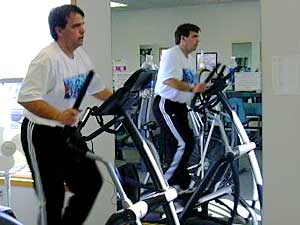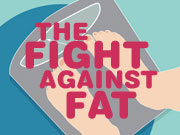Small towns face a fitness gap
June 2, 2003
 |
| Bob Johnson works out daily at the community-owned fitness center in Ada. (MPR photo/Dan Gunderson) |
Moorhead, Minn. — About a dozen men and women gather at tables in the meeting room of a cafe in downtown Henning, in northwestern Minnesota. The volunteer group is known as the Community Health Action Team. Connie Tiede calls the meeting to order. She's a pastor who lives in the nearby town of Vining. Others on the team are business owners, retirees, educators, local politicians and health professionals. Their goal is to promote various health initiatives. This year they're looking for ways to get more people to exercise.
There's not much money. They have $500 for a fitness project. Connie Tiede says the long-range goal is to start a health club, maybe in an empty storefront on the main street. She says the group will be looking for grants to pay for the project.
If Henning residents want to work out, there are few choices. People can walk or run in the school gym, but most nights it's filled with student athletes. In nearby Vining, where Connie Tiede lives, the only walking track is the city streets.
 | |||
"When I go out and walk during the day, I walk around town three times just to get two miles in, because Vining is only three or four blocks long," says Tiede.
Tiede has a treadmill at home where she often logs a few miles. She says many elderly residents can't afford that luxury. Tiede says she's also concerned about a lack of recreational activities for kids.
"They don't go out and go play tennis or play basketball or play volleyball. That's just not available as far as outdoor recreation," says Tiede.
Henning is a town of about 700 people. Two-thirds are senior citizens. Mayor Dave Holmgren is 70. He's a former marathon runner. He still walks about three miles a day, year-round.
"I walk outside. I've still got that little macho in me. I'm going to go out every day no matter what," says Holmgren. "I missed about four days this winter. You put enough clothes on you can do that."
Mayor Holmgren says the discipline pays off. He has no health problems. Unlike most of his senior citizen friends, he takes no medication.
 | |||
Dave Holmgren says he would like to see a health club in Henning. But he says people here are mostly low and moderate income. They can't afford higher taxes to pay for new city facilities.
"I hate to put the dollar on everything, but in small towns, money is scarce," says Mayor Holmgren. "Locally here, we approved a referendum a year ago to keep the school going. That adds on taxes of course, so taxes went up a couple hundred dollars for everybody. To add more taxes to give them some kind of sports or health equipment or building just wouldn't go."
And Holmgren wonders, if Henning had a health club, would the mostly elderly residents actually use it? He thinks physical fitness is more about self-discipline than buildings and equipment.
Jon Wigert says sometimes it doesn't take much to get an overweight person to start exercising. Wigert is a doctor who's worked in Henning for 20 years. He says a pedometer project is a good example of a bare-bones fitness program.
The beeper-sized device measures how many steps a person takes. Wigert says it's amazing how effective it's been to have people wear a pedometer.
 | |||
"They drive around in their car all day, and they'll look at the pedometer when they get home at night and it says 500 steps. The recommendation is now that you get 10,000 or 11,000 steps a day. And they see that number and they say, 'My goodness, I've got to get moving,'" says Wigert.
The Centers for Disease Control recommends at least 30 minutes of exercise a day.
At the community center in Ada, Bob Johnson is sweating through his morning workout. The middle-aged crop duster is on a mission to get rid of the flab around his midsection. He was about 60 lbs. overweight when he started working out in January.
"I was laying in bed one morning. Couldn't sleep, it was 6 a.m., I felt terrible, my back hurt. I felt like an old man lying in bed," says Johnson. "I got up and I said, 'It's time.'"
Bob Johnson is lucky. Ada is somewhat unusual for a small town. It has a community fitness center with state-of-the-art workout equipment, racquetball courts, a swimming pool and walking track. About 80 percent of the $1 million facility was paid for with donations. Most of the money came from one private local donor. City bonds paid the rest, about $200,000.
|
It's about discipline. I think it's also about experience with exercise and how much better you feel.
- Marion Kershner, Ottertail County public health nurse |
People pay memberships to use the club, but that doesn't cover the cost of operations. The city spends about $100,000 a year to operate the health club. Community fundraisers pay for new equipment.
About 1,600 people live in Ada. Every day, 50 to 150 people use the health club. Many are senior citizens. Bob Johnson says that number should be higher.
"It's a place a bigger city would be proud of, and we've got it here in little old Ada," says Johnson. "To not use the facility -- it's just ludicrous."
Bob Johnson has lost more than 40 pounds. His blood pressure is down. He feels great. He doubts he'd have changed his lifestyle without a convenient place to work out in Ada. He would have to drive 40 minutes to Fargo.
"There's no way I would have done this if I had to drive to Fargo every day to do it. I get bored and broke, and end up wasting the money for a membership and don't get anything done," says Johnson.
Travel and cost are barriers for people in many small towns. The nearest health club may be an hour away. A health club membership may be too costly.
Ottertail County public health nurse Marion Kershner doesn't buy any such excuses. Kershner is working on a project to improve the health and fitness of county residents.
Henning is one of the towns involved in the county-wide project. Kershner says it may not be easy, but people who are committed to fitness can always find a way to exercise.
"We have many months of the year where getting outside and walking and being physically active is more of a challenge. So we can make that excuse for ourselves," says Kershner. "It's about discipline. I think it's also about experience with exercise and how much better you feel (when you exercise)."
Kershner says exercise is perhaps the simplest and most effective way to combat the obesity epidemic. The challenge is to get people moving.
|
News Headlines
|
Related Subjects
|

